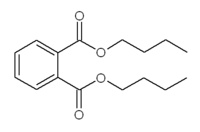Dibutylphthalate
Definition of dibutylphthalate (DBP):
Dibutylphthalate belongs to the family of phthalates: industrial chemicals used as plasticizers, softeners, adhesives or solvents used by a variety of industries. They are used in PVC, paints, printing inks, cosmetics, coatings of cars,...[1].
This is the common definition for dibutylphthalate (DBP), other definitions can be discussed in the article
|
Notes
| Dibutylphthalate |
|---|

|
| Formula |
| C16H2204 |
DBP can enter the marine environment through waste water effluents. Cleaning of road tankers releases DBP to the aquatic environment. DBP has a low water solubility (10 mg/l), and tends to adsorb to sediments. It is very stable but can be biodegraded, causing it to have an environmental half-life of 50 days. It has some potential to bioaccumulate in some organisms, however because of its biodegradability it is not expected to biomagnify through food chains.
Concentrations above 0,04 mg/l are shown to cause adverse effects on aquatic invertebrates and concentrations above 0,2 mg/l can have lethal effects. Concentrations above 0,5 mg/l can cause acute toxicity for fishes. It has also been show to be able to act as an endocrine disruptor in vertebrates. As such it causes adverse effects on the development and reproduction of rats[1].
In sea water concentrations of 3 µg/l have been measured, although they are usually below 0,5 µg/l. Concentrations in sediments can reach 2,4 mg/kg dry weight but are usually around 0,01 mg/kg dry weight.
There is a potential risk for ecotoxicological effects of dibutylphthalate on aquatic species in the marine environment, but only at a local scale and mainly for organisms living in sediments[1].
Environmental standards and legislation
Included in the OSPAR list of substances of priority action
See also
OSPAR background document on phthalates
References
Please note that others may also have edited the contents of this article.
|